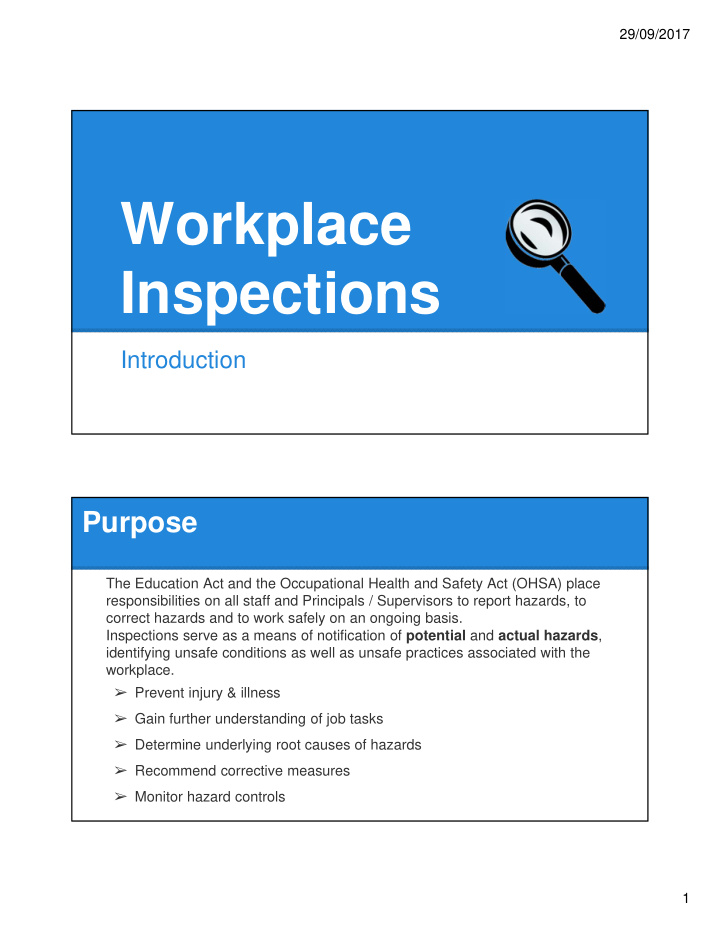



29/09/2017 Workplace Inspections Introduction Purpose The Education Act and the Occupational Health and Safety Act (OHSA) place responsibilities on all staff and Principals / Supervisors to report hazards, to correct hazards and to work safely on an ongoing basis. Inspections serve as a means of notification of potential and actual hazards , identifying unsafe conditions as well as unsafe practices associated with the workplace. ➢ Prevent injury & illness ➢ Gain further understanding of job tasks ➢ Determine underlying root causes of hazards ➢ Recommend corrective measures ➢ Monitor hazard controls 1
29/09/2017 The Committee’s role Annual inspections completed by the Central JHSC help ensure a well functioning Internal Responsibility System (IRS) and provide a fresh set of eyes for identifying hazards. It can also help with consistency of control measures across the board. Getting Prepared TO DO: TO BRING: Review inspection schedule created and Hazard ID Booklet posted by the co-chairs. Blank Inspection Worksheet for eSolutons Arrange date and start time with school and pen Administrator. Appropriate attire Remind the School Administrator to invite the In-School Health and Safety Team members. Note their full participation is not required to carry out an annual inspection. Review previous annual or monthly inspections for that school in eSolutions. Familiarize yourself with what to look for in your Hazard ID Booklet. Enter time in SmartFind Express Attendance Program. 2
29/09/2017 Inspection Worksheet myHDSB> Departments> Human Resources > Forms > Choose Form IW Hazard Identification Booklet Available from the Health & Safety Department 3
29/09/2017 ADMINISTRATIVE HAZARDS AIR QUALITY & BUILDING HAZARDS 4
29/09/2017 Chemical & Electrical Hazards ERGONOMIC & EQUIPMENT HAZARDS 5
29/09/2017 FALL HAZARDS (from height) HAZARD CONTROL & FIRE SAFETY 6
29/09/2017 MISCELLANEOUS HAZARDS SLIP / TRIP & STORAGE HAZARDS 7
29/09/2017 What to look for Look up, down, and around... Consider the various working environment: What to look for (continued) Classroom: No items hanging from the ceiling? No tripping hazards along the ground? Electrical outlets not overloaded? Are there over-loaded shelves starting to bow? Emergency posters missing by exit? Unlabelled spraybottles/chemicals? No leaks under the sink or above the ceiling? 8
29/09/2017 What to look for (continued) Office and Staff Room: - No items hanging from ceiling tiles/light fixtures? - No curling carpet or other trip hazards? - No overloaded electrical outlets? - Paper cutter in good repair and stored properly? - Are file cabinet doors being left open in walkways? - Is the H&S board missing any items? - Is the first aid kit accessible and inspected regularly? What to look for (continued) Hallways: - Are egress routes kept clear of clutter? - Is the 3ftx12ft rule followed for posted materials? - Are emergency Exit signs in good repair? - Are items being stored under a stairwell? - Are fire extinguishers/AED getting inspected monthly? - Do you notice any door closers sticking or not working? 9
29/09/2017 What to look for (continued) Storage Areas: - No items toppling over? - No long items stored upright and unsecured? - Are items blocking sprinkler head or exits? - Are shelving units over 4ft secured to wall? - Are there chemicals stored inappropriately? What to look for (continued) Tech/Auto Workshops: - Are emergency exits kept clear? - Are eyewash stations in working condition? - Are there any spills not cleaned up? - Are safety lines present for machinery? - Is Personal Protective Equipment (PPE) available for teaching staff? - Is there any damaged or missing machine guarding? 10
29/09/2017 What to look for (continued) Science Rooms and Chemical storage: - Are eyewash stations accessible and in working condition? - Are spill kits available and stocked? - Are all chemical containers labelled? - Are chemicals being properly stored? - Is personal protective equipment (PPE) available for staff? - Is the fume hood working properly? - Do staff know where to get MSDS? What to look for (continued) Facilities/Mechanical Rooms: - Are good housekeeping practices being followed? - Are excessive items being stored in electrical rooms? - Are there chemicals stored improperly? - Are shelving units over 4 ft secured to the wall? - Are decanted chemical products properly labelled? 11
29/09/2017 What to look for (continued) Portables: - Are the front stairs & railing in good repair? - Are there items hanging from the ceiling? - Are there curled rugs or cords running along floor? - Is the electrical panel accessible? - Is there overloaded shelving? What to look for (continued) Outdoors: - Are potholes or damaged concrete identified? - Are there any burnt out lights reported? - Are walkways properly cleared/treated (winter) - Are large icy patches identified? (winter) 12
29/09/2017 What Not to Report You may come across items you wish to bring up to management, but that do not belong on the Workplace Inspection Report as they do not present a safety hazard. Feel free to jot down your concerns and address them with the administrator separately. This may include: Building maintenance items (i.e. broken clock, damaged paper towel holder, graffiti on washroom wall) Student safety related items (i.e. play equipment in need of repair) Staff wish list items (i.e. wants carpet replaced with no evident safety concern) Top Reported High Risk Hazards Fire Safety Building Related Hazards Hazards Electrical Hazards 13
29/09/2017 Important Tips Address imminent hazards immediately Dress appropriately - as part of promoting safety in the workplace, we need to lead by example. Be sure to wear closed-toe shoes with good treads when you know you will be entering tech and mechanical areas. Be detailed - when noting hazards and locations down, be as detailed as possible so there is no confusion when referring back to them. For additional support: Discuss with other JHSC members Check resources on MYHDSB.ca https://www.myhdsb.ca/Departments/HR/HealthandSafety/Pages/InSchoolHealthandSafetyTeams.aspx Contact the Health & Safety Department H&S Manager: Judi Goldsworthy ext. 3221 H&S Assistant: Mical Salovaara ext. 3396 H&S Specialist: Kerri Snell ext. 3347 H&S Specialist: Melissa Rozon ext. 3223 14
29/09/2017 15
Recommend
More recommend